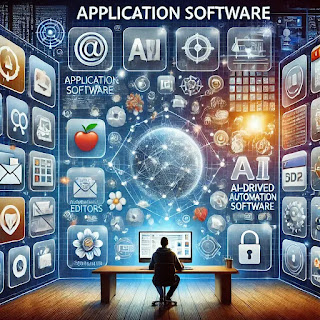Understanding Application Software: Its Role and Importance
Application software is essential for performing specific tasks on a computer, enabling users to complete work efficiently and effectively. These programs range from productivity tools to entertainment applications and play a crucial role in modern computing. This blog post explores application software, its types, and its impact on daily life.
1. What is Application Software?
Application software refers to programs designed to perform specific functions for users. Unlike system software, which manages hardware and system operations, application software allows users to accomplish various tasks such as word processing, web browsing, and graphic design.
2. Types of Application Software
a. Productivity Software
Designed to help users perform tasks efficiently.
Examples: Microsoft Office (Word, Excel, PowerPoint), Google Docs, and Notion.
b. Multimedia Software
Enables users to create, edit, and play multimedia content.
Examples: Adobe Photoshop, VLC Media Player, and Audacity.
c. Web Browsers
Allow users to access and navigate the internet.
Examples: Google Chrome, Mozilla Firefox, Safari, and Microsoft Edge.
d. Communication Software
Facilitates online communication and collaboration.
Examples: Zoom, Skype, Microsoft Teams, and Slack.
e. Database Management Software
Helps in managing, storing, and organizing data.
Examples: MySQL, Microsoft Access, and Oracle Database.
f. Gaming Software
Provides entertainment through interactive digital experiences.
Examples: Steam, Xbox Game Pass, and Epic Games Launcher.
g. Security Software
Protects systems from viruses, malware, and cyber threats.
Examples: Norton Antivirus, McAfee, and Bitdefender.
3. Importance of Application Software in Daily Life
Application software has transformed various industries, improving efficiency and connectivity:
Business & Productivity: Streamlines workflows, enhances collaboration, and increases productivity.Education: Facilitates remote learning, online research, and skill development.
Entertainment: Offers digital media consumption, gaming, and creative expression.
Healthcare: Assists in patient management, medical imaging, and diagnostics.
4. Future Trends in Application Software
Cloud-Based Applications: Increasing reliance on cloud storage and software as a service (SaaS).
Artificial Intelligence Integration: AI-powered applications improving automation and efficiency.
Augmented Reality (AR) and Virtual Reality (VR): Enhancing user experiences in gaming, training, and education.
Cross-Platform Applications: Applications designed to function across multiple devices and operating systems.
Application software is a fundamental part of modern computing, enabling users to perform tasks ranging from business operations to entertainment. As technology continues to evolve, application software will become more advanced, driving innovation and improving user experiences.
👇What applications do you use most frequently? Share your thoughts in the comments below!👇
References
Sommerville, I. (2020). Software Engineering. Pearson.
Pressman, R. S., & Maxim, B. (2020). Software Engineering: A Practitioner's Approach. McGraw-Hill.
Laudon, K. C., & Laudon, J. P. (2021). Management Information Systems: Managing the Digital Firm. Pearson.
Microsoft. (2023). Application Software Overview. Retrieved from https://www.microsoft.com
Adobe. (2023). Creative Cloud: Multimedia Software Solutions. Retrieved from https://www.adobe.com
Oracle. (2023). Database Management Systems and Enterprise Applications. Retrieved from https://www.oracle.com




Comments
Post a Comment